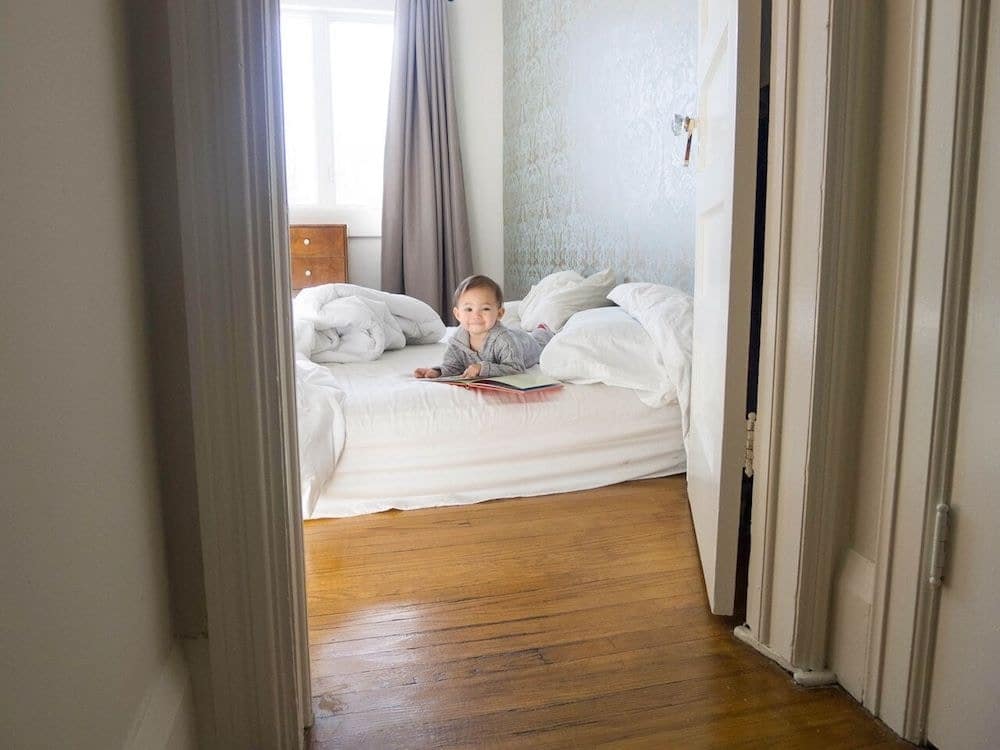Time for a toddler bed? How to ease the transition
When it’s time to transition from crib to toddler bed, these simple tips can make it easy for both Mama and child.

So your toddler is ready to move into her own bed. Everyone is excited except now, instead of rolling over and falling asleep, your toddler comes out every two minutes to find you. All evening long. The next day, she’s a basket case because she’s so exhausted.
Welcome to the toddler bed. Kids love the newfound freedom, and they can’t help but test the limits. Being all by themselves with no sides can feel very scary, so how can you get them to form the new habit of falling asleep in their big-kid bed without you losing your mind?
Going into this transition is a big move for your child. Naturally, it makes them insecure. They need your support to learn how to go to sleep in their big-kid bed. Sure, it comes naturally to you. But you’ve been doing it for many years. To your toddler, this is a new skill.
Don’t expect to have much of an evening for a week or so. Then, just stay calm and keep reinforcing the limit that it’s bedtime. Here’s how:
1. Before you make the big transition, be sure your child has a regular bedtime routine. Then follow that exact routine when they move to their new bed.
2. Get them excited before you get the new bed. Introduce the subject by pointing out any friends or cousins with “big kid” beds. Reading books is also a terrific way to introduce the idea.
3. Don’t initiate the transition from the crib while they are potty training, or when you’re moving to a new house. It might seem easiest not to move the crib, but that’s more change than most little people can handle all at once, and you’ll find it just isn’t worth it.
4. If you’re transitioning your child to make room in the crib for a new sibling, be sure the move occurs a good three months before you expect the new baby. You want your toddler to be happy in their new bed before they see an interloper in their crib. If your child is not really ready to leave their crib, you can save all of you a lot of grief by borrowing a second crib for awhile, until they’re ready.
5. It’s a good idea if the toddler bed can be in the same place where the crib was.
If your kids will be sharing the room, move the crib to a new place in the room if you can.
6. If at all possible, let your child pick the bed. If someone is giving or loaning you a toddler bed, stress to your child that she gets Cousin Jane’s bed now, because they are almost as big as Cousin Jane. When the bed is delivered, let your child help unpack and assemble it.
7. If you’re using a regular twin bed, start off with the mattress on the floor—rather than on a bed frame—for both safety and coziness (we like the Newton washable organic twin mattress). You can add the bed frame in a couple of years, or look into doing a Montessori floor bed, which is essentially a bed on the floor, with or without a frame.
8. Make their new bed cozy, like a little den. It’s important to make sure you use as many things from the crib as possible (blankets, for instance) so that they feel comfortable in the new bed. It’s fine to let them pick out new superhero sheets, but their crib blanket is what they’ll need most. Most kids love being surrounded by stuffed animals.
Be sure to use guardrails; in addition to being safer, they help kids feel more secure, so they’re less likely to keep getting out of bed.
9. If your bedtime routine does not include an audio element, consider adding it. Many toddlers fall asleep more easily while listening to familiar, calming music. Over time, as soon as they hear the music, it will become a cue for their body to begin settling into sleepiness.
Depending on the age of your child, there are also wonderful bedtime story and relaxation audios, but you’ll need to read reviews and listen in advance to be sure they’re age appropriate. The great thing about a story, even one that’s repeated every night, is that it keeps your child’s attention so they don’t get worried and keep coming to find you.
10. Before the big night, act out the scenario with stuffed animals. Your toddler will watch avidly as the little elephant kisses mama or daddy goodnight and snuggles under the covers in their own bed. Have the parent stuffy sing the little elephant the same good night songs you sing to your little one. This will help them understand what’s going to happen.
11. On the big night, initiate bedtime an hour earlier than usual. Explain to your child that they are going to sleep in the big bed tonight. Go through the normal bedtime routine. What you do next depends on your child.
Some kids can handle it if you sit in the doorway of the room, reading with a book light, while they fall asleep. But most kids need us to sit right next to them, on the bed. That way they feel your presence acutely, which will give them great reassurance.
Of course, if you need to cuddle them so they feel safe enough to fall asleep, by all means, do so. They don’t need to get out of bed to find you, so they’ll develop the habit of snuggling down and going to sleep, rather than of getting out of bed to look for you.
12. If they try to engage you in conversation, just say, “We’ll talk tomorrow. It’s sleep time now.” Keep your attitude positive, respectful, and detached. Be boring and consistent.
13. If they start to get out of bed, say, “It’s bedtime, you need to stay in bed.” Move closer so you can gently keep them in bed if they begin to get up. Stay calm, respectful, and empathic, as in, “It’s a big change, sleeping in your new bed. Soon you’ll be used to it.” But don’t let them get out of bed. You don’t want them developing that habit. Stay as close to the bed as you need to, to start. This eases the transition and lets your child learn to fall asleep in the new bed.
Are you developing a bad habit? No. This is a transition, and you will be able to ease out of it once your child is comfortable in the bed.
14. If your child cries, comfort them. Some children are very frightened of their parent leaving and will cling to you. In that case, remind yourself that this fear needs expression, and don’t leave your child alone to cry. Instead, when they begin to cry, stay with them and let them cry as much as they need to. As they begin to stop, let them know that now you’ll be leaving. In other words, you don’t actually ever leave them crying. You simply remind them that you’ll be leaving, and then help them with the anxiety that surfaces. Stay as close as you need to, to comfort them—and move only as far away as you need to so that their fear comes up. After they “show you” their fear, it will evaporate. Yes, that may take a few days, but sooner or later they will no longer be frightened when you say you need to leave.
Is this sleep training? It would be more accurate to say that your child is having a hard time separating from you to fall asleep, so you are helping them to surface and dissolve the fears that are causing their separation anxiety.
Notice that you never leave them alone to cry. Instead, you announce your plan to leave and then help your child through their fearful reaction. Anxiety—another word for fear—is often at the root of children’s sleep issues. While there is nothing at all wrong with a toddler sharing their parents’ bed, children who can understand what you are telling them are certainly capable of sleeping alone, once they get some help with their fears.
15. Give lots of positive acknowledgment when your child does fall asleep in their own bed without trying to get out, and even for progress in the right direction. You can say, “I noticed that I only had to remind you twice to stay in bed last night. You must be so proud of yourself. Soon you will feel so good in your new bed that you’ll be able to snuggle right down and go to sleep all by yourself!”
16. If you’ve been lying on the bed until your child falls asleep, gradually move yourself over so you’re just holding hands and sitting in a chair. Then, stop holding their hand. Then, move your chair further away until you’re sitting in the doorway. This could take you a month, or it might just be a week.
17. If your little one has a hard time falling asleep night after night, consider the possibility that they’re over-tired from falling asleep later than usual, and move their bedtime earlier.
Toddlers have to pump themselves full of cortisol and adrenaline to stay up later than usual, and that makes it harder to fall asleep. Oddly enough, an earlier bedtime usually solves the problem when the child is just too wound-up to relax. Another helpful thing to try: roughhousing. Not right before bed, because it winds up the child, but earlier, before dinner or bath.
Laughter reduces the stress hormones circulating in the body and helps the child relax at bedtime.
18. Within a few days of your sitting in the doorway, your child will be falling asleep without trying to get out of bed, and you can begin leaving for a few minutes, and then for longer periods of time. Just say you’ll be right back, and keep checking back. It helps to leave the chair in place, like a sentinel, to reassure your child if they look for you.
19. If your toddler just can’t seem to fall asleep, you might consider letting them take books (not toys) to bed with them. If you have a nightlight or enough light from the hall, they can “read” themselves to sleep. Lots of adults need to read a bit before they fall asleep. It isn’t such a bad habit for your child to develop, as long as they actually fall asleep. Just be sure the light is very dim, so it doesn’t keep them up.


